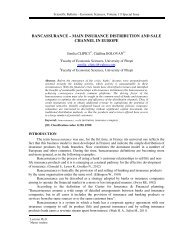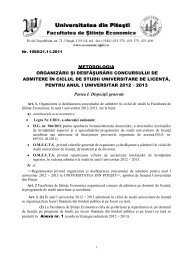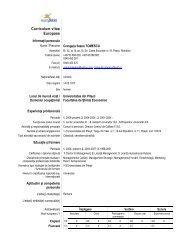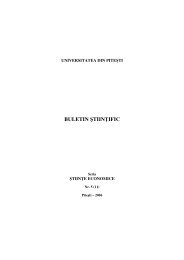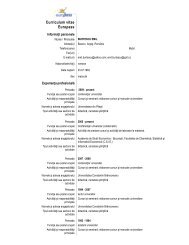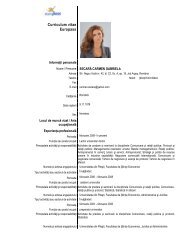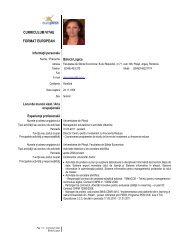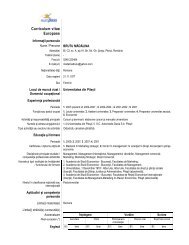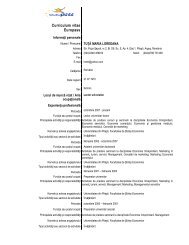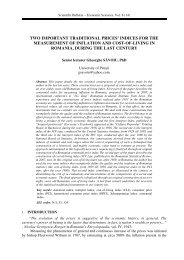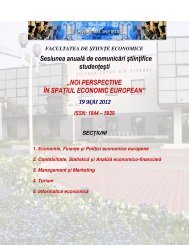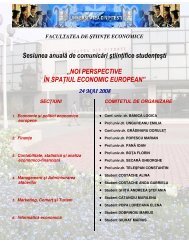buletin Åtiin ific - Facultatea de Stiinte Economice - Universitatea din ...
buletin Åtiin ific - Facultatea de Stiinte Economice - Universitatea din ...
buletin Åtiin ific - Facultatea de Stiinte Economice - Universitatea din ...
- No tags were found...
Create successful ePaper yourself
Turn your PDF publications into a flip-book with our unique Google optimized e-Paper software.
The effects of the atmospheric pollution upon the green spaces and the vegetation of Piteşti municipalityand the influence of the various types of soil, fertilizers and crop rotations, upon the variouscultures and their production. Another part of the researches has followed the influence of the<strong>de</strong>nsity, of the see<strong>din</strong>g periods, of herbici<strong>de</strong>s and phitosanitary treatments on different kinds andspecies of plants. Together with these directions, which have been strictly in the area of activityof SCCPT Albota, a special attention was given to the influence of atmosphere polluting onplants and cultures in general. 28From the start we have to stipulate that the observations and conclusions have beeneffectuated both in experimental fields of SCCPT – Albota, situated in the area of Albotalocality, as well as on some parcels that belong to private persons of the five localities.It is obvious that for the present work the interest is represented by the effects of the airpollution upon the growth and evolution of plants.We cannot say the same about the corn, wheat and sunflower cultures from the personal,private parcels. Their vegetation condition was clearly inferior, first of all, due to their incapacityof applying the agricultural technologies that lead to a <strong>de</strong>crease of the resistance of these plantsand the action of polluter agents. There was observed that especially the sun flower culture washighly affected, as due to these polluting agents parts of the leaves, and in some cases, the entireleaves, were attacked (necrosis) which lead to a reduction of the growth.A larger influence of the polluter agents was noticed on the vegetable cultures in thepeasants’ gar<strong>de</strong>ns. Although during the first part of the year these had a normal evolution,starting with July, especially the tomatoes, eggplants, pepper and bean cultures were affected,especially after the rains during the period 7-10 July 2006. It was conclu<strong>de</strong>d that the rains havestimulated these polluters (especially HCl, SO2, SO3) transforming into acid rains that haveattacked the plants, especially the leaves, lea<strong>din</strong>g to their necrosis. Such effect was also noticedon the grape vine where the grapes were also affected.This effect was noticed not only by me but also by the villagers. These effects were alsonoticed on the trees in Pitesti, the lime trees being the most affected, in the sense of their leavesdying on the course of July 2006. The trees from the Prundu area and those along the FratiiGolesti street and the Republicii Boulevard on the South Railway station portion and the BCR –public finances area have suffered the most in this sense.The observations ma<strong>de</strong> in 2006 and 2007 and the conclusions drawn from these aresimilar to the ones in 2005.What interests us regar<strong>din</strong>g the agricultural cultures is to obtain productions as great aspossible on each hectare, and in or<strong>de</strong>r to obtain this objective there are many factors involved,amongst these the pollution of the air. It was noticed, on the experimental parcels, that if all thestages of the technological process are respected the productions can be larger, and the influenceof the pollution can be diminished (inclusively by creating and using resistant species). But, ifthe stages of the technological process are not respected then the pollution, even if more reduced,has a greater influence on the reduction of the production. Here we encounter the reducedresistance of the plants in front of the action of the polluting factors in the conditions in whichthe plants already suffer because of the inappropriate application of the agricultural technology. 29In these conditions the clearest and strongest effects were those of the present polluters(especially SO2 and HCl which was present in the atmosphere in the highest concentration) onthe cultures of the individual agricultural owners. These do not have the economical andfinancial power necessary in or<strong>de</strong>r to make all the agricultural works accor<strong>din</strong>g to the accor<strong>din</strong>gto the scient<strong>ific</strong> recommendations and mo<strong>de</strong>rn technologies.During these years the effects of the pollution cumulated to those of the drought lead, insome places and especially in the later see<strong>de</strong>d sun flower, corn and wheat cultures, and also thein vegetables ones to their calamity in various proportions (from 10% up to 60-70%).28 Gâşteşcu, P., „Ecologia aşezărilor umane”, Edit. Univ. Bucureşti, 1998, p. 96;29 Miu Florentina, „Clima şi poluarea aerului în municipiul Piteşti”, Editura Universităţii <strong>din</strong> Piteşti 2006, p. 286;71




